These archive pages are provided in order to make it easier for you to find items
that you remember seeing on the Airplanes and Rockets homepage. Of course probably
the easiest way to find anything on the website is to use the "Search AAR" box at
the top of every page.
1 |
2 |
3 |
4 |
5 |
6 |
7 |
8 |
9 |
10 |
11 |
12 |
13 |
14 |
15 |
16 |
17 |
18 |
19 |
20
21 |
22 |
23 |
24 |
25 |
26 |
27 |
28 |
29 |
30 |
31 |
32 | 33

 You might have heard about the new OpenAI
information generation engine called ChatGPT. It is a publically accessible tool
for creating textual content on just about any subject. I decided to test ChatGPT's
mettle by having it write a series of
definitions for common aeronautical
terms. The result, as you can see for yourself, are impressive. Thus far I have
not found any inaccurate information. I wrote a short article about
ChatGPT for my RF Cafe engineering website. Please take a couple minutes and
check some of these definitions for yourself:
Airfoils,
Dihedral
/ Polyhedral, Planform,
Aspect Ratio, etc.
ChatGPT produces only text - no images or even hyperlinks to other websites... You might have heard about the new OpenAI
information generation engine called ChatGPT. It is a publically accessible tool
for creating textual content on just about any subject. I decided to test ChatGPT's
mettle by having it write a series of
definitions for common aeronautical
terms. The result, as you can see for yourself, are impressive. Thus far I have
not found any inaccurate information. I wrote a short article about
ChatGPT for my RF Cafe engineering website. Please take a couple minutes and
check some of these definitions for yourself:
Airfoils,
Dihedral
/ Polyhedral, Planform,
Aspect Ratio, etc.
ChatGPT produces only text - no images or even hyperlinks to other websites...
 Who will be able to afford to buy and maintain
it? "Germany-based MT-Propeller has an
11-blade propeller in the works, testing it on a Piper PA31T1 with Pratt &
Whitney PT6A-135 turbine engines. The world’s first 11-bladed propeller recently
'took the sky with an impressive noise and sound signature,' company officials said.
'The very promising results in static thrust, 15% increase over the standard certified
5-bladed propeller, and the jet-noise signature showed…what could be possible in
the propeller developments,' company officials added. The propeller system, combined
with a low RPM power supply from a turbine or an electric engine, opens new possibilities
for performance, efficiency, and noise, MT-Propeller officials noted..." Who will be able to afford to buy and maintain
it? "Germany-based MT-Propeller has an
11-blade propeller in the works, testing it on a Piper PA31T1 with Pratt &
Whitney PT6A-135 turbine engines. The world’s first 11-bladed propeller recently
'took the sky with an impressive noise and sound signature,' company officials said.
'The very promising results in static thrust, 15% increase over the standard certified
5-bladed propeller, and the jet-noise signature showed…what could be possible in
the propeller developments,' company officials added. The propeller system, combined
with a low RPM power supply from a turbine or an electric engine, opens new possibilities
for performance, efficiency, and noise, MT-Propeller officials noted..."
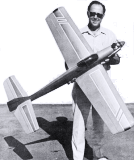 Website visitor Steve S. asked for a scan
of Phil Kraft's Dragon-Fli
pattern plane. It appeared in the January 1971 American Aircraft Modeler magazine
on page 19. Precision / advanced aerobatics airplanes have undergone a significant
transmogrification from somewhat boxy outlines with only slightly larger than normal
control surfaces and retractable, tricycle gear, to curvaceous tail draggers with
fixed gear. Programmable radio with multiple throw rates and control mixing have
permitted a lot of freedom in the configuration of the entire aircraft... Website visitor Steve S. asked for a scan
of Phil Kraft's Dragon-Fli
pattern plane. It appeared in the January 1971 American Aircraft Modeler magazine
on page 19. Precision / advanced aerobatics airplanes have undergone a significant
transmogrification from somewhat boxy outlines with only slightly larger than normal
control surfaces and retractable, tricycle gear, to curvaceous tail draggers with
fixed gear. Programmable radio with multiple throw rates and control mixing have
permitted a lot of freedom in the configuration of the entire aircraft...
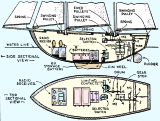 Anyone entering the radio control hobby
since the era of 2.4 GHz radios, with their couple-inch-long antennas, might
be glad they weren't around in the 1970's through Y2K when three-foot-long antennas
on the transmitter and receiver seemed cumbersome. They were, to some extent, but
I still use my 72 MHz R/C system in models. Those of us who grew up with the
27 MHz and 72 MHz systems are equally queasy about the early days of R/C
when an amateur radio license was required and nearly all units were home-built,
and operating frequencies in the 78-meter band required a ¼-wave transmitter wire
antenna of 58 feet be rolled out if positive control is desired. Such was the
case with this "improved" radio control system appearing in a 1936 issue of Radio-Craft
magazine. I salute the fortitude and technical prowess of my forebears in the hobby,
but am very glad to not have been one of them... Anyone entering the radio control hobby
since the era of 2.4 GHz radios, with their couple-inch-long antennas, might
be glad they weren't around in the 1970's through Y2K when three-foot-long antennas
on the transmitter and receiver seemed cumbersome. They were, to some extent, but
I still use my 72 MHz R/C system in models. Those of us who grew up with the
27 MHz and 72 MHz systems are equally queasy about the early days of R/C
when an amateur radio license was required and nearly all units were home-built,
and operating frequencies in the 78-meter band required a ¼-wave transmitter wire
antenna of 58 feet be rolled out if positive control is desired. Such was the
case with this "improved" radio control system appearing in a 1936 issue of Radio-Craft
magazine. I salute the fortitude and technical prowess of my forebears in the hobby,
but am very glad to not have been one of them...
 "At
Moffett Field in Mountain View, CA,
Lighter Than Air (LTA) Research is floating a new approach to a technology that
saw its rise and fall a century ago: airships. Although airships have long since
been supplanted by planes, LTA, which was founded in 2015 by CEO Alan Weston, believes
that through a combination of new materials, better construction techniques, and
technological advancements, airships are poised to - not reclaim the skies, certainly
- but find a new niche. Although airships never died off entirely - the Goodyear
blimps, familiar to sports fans, are proof of that - the industry was already in
decline by 1937, the year of the Hindenburg disaster. By the end of World War II,
airships couldn’t compete with the speed airplanes offered, and they required larger
crews. Today, what airships still linger serve primarily for advertising and sightseeing.
LTA's Pathfinder 1 carries bigger dreams than hovering over a sports stadium,
however..." "At
Moffett Field in Mountain View, CA,
Lighter Than Air (LTA) Research is floating a new approach to a technology that
saw its rise and fall a century ago: airships. Although airships have long since
been supplanted by planes, LTA, which was founded in 2015 by CEO Alan Weston, believes
that through a combination of new materials, better construction techniques, and
technological advancements, airships are poised to - not reclaim the skies, certainly
- but find a new niche. Although airships never died off entirely - the Goodyear
blimps, familiar to sports fans, are proof of that - the industry was already in
decline by 1937, the year of the Hindenburg disaster. By the end of World War II,
airships couldn’t compete with the speed airplanes offered, and they required larger
crews. Today, what airships still linger serve primarily for advertising and sightseeing.
LTA's Pathfinder 1 carries bigger dreams than hovering over a sports stadium,
however..."
 The Academy of Model Aeronautics (AMA) has
a webpage filled with great vintage
videos showcasing key moments and accomplishments in model aviation. Included
is a documentary on Dr.'s Walt and Bill Good, who pioneered radio control electronics
and airframes to pave the way for incredibly complex and reliable systems we enjoy
today. "The Choppers" takes a look at the history of R/C helicopters, beginning
with the 1971 Nats when two of Dieter Schlueter's AH-1G Bell Huey Cobras were flown.
"Wired For Excitement" covers control line airplanes for stunt, scale, combat, speed,
and carrier. "Adrift on the Air... the Fun of Free Flight Flying" introduces the
aspect of free flight aeromodeling, with gliders, rubber, and fuel power. Visit
the AMA's YouTube channel
for hundreds of great videos - both historical and contemporary! The Academy of Model Aeronautics (AMA) has
a webpage filled with great vintage
videos showcasing key moments and accomplishments in model aviation. Included
is a documentary on Dr.'s Walt and Bill Good, who pioneered radio control electronics
and airframes to pave the way for incredibly complex and reliable systems we enjoy
today. "The Choppers" takes a look at the history of R/C helicopters, beginning
with the 1971 Nats when two of Dieter Schlueter's AH-1G Bell Huey Cobras were flown.
"Wired For Excitement" covers control line airplanes for stunt, scale, combat, speed,
and carrier. "Adrift on the Air... the Fun of Free Flight Flying" introduces the
aspect of free flight aeromodeling, with gliders, rubber, and fuel power. Visit
the AMA's YouTube channel
for hundreds of great videos - both historical and contemporary!

 Buzz Aldrin has always been
my favorite astronaut. He is the subject of my
January 20th RF Cafe
website logo. Aside from being the second human to set foot on the moon during the
Apollo 11 mission, the West Point alum has a reputation as brilliant engineer,
decorated fighter pilot, pull no punches opinions, and sharp witticism. No modern
being has earned the right to be considered a role model than Dr. Aldrin (astronautics,
MIT). Legend has it that
Buzz Lightyear was named in honor of him. At 93 years old, he is still outspoken
on matters of science and infinitely more lucid than many people decades his younger
and even some presidents. It came as no surprise when this headline appeared last
Friday: "Astronaut
Buzz Aldrin gets married to 63-year-old girlfriend on 93rd birthday: 'As excited
as eloping teens.'" In this age of compromised masculinity, it is good to have an
authentic "man's man" (and evidently "woman's man") in our midst. Buzz Aldrin has always been
my favorite astronaut. He is the subject of my
January 20th RF Cafe
website logo. Aside from being the second human to set foot on the moon during the
Apollo 11 mission, the West Point alum has a reputation as brilliant engineer,
decorated fighter pilot, pull no punches opinions, and sharp witticism. No modern
being has earned the right to be considered a role model than Dr. Aldrin (astronautics,
MIT). Legend has it that
Buzz Lightyear was named in honor of him. At 93 years old, he is still outspoken
on matters of science and infinitely more lucid than many people decades his younger
and even some presidents. It came as no surprise when this headline appeared last
Friday: "Astronaut
Buzz Aldrin gets married to 63-year-old girlfriend on 93rd birthday: 'As excited
as eloping teens.'" In this age of compromised masculinity, it is good to have an
authentic "man's man" (and evidently "woman's man") in our midst.
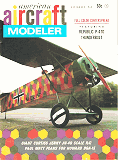 Not all old adages are still true. Waaaay
back in the last century, even as recently as the late 1990's and early 2000's,
that is to say before the advent of 2.4 GHz, spread spectrum radio systems,
brushless motors, and LiPo batteries for model use, you could make the argument
proclaimed here in this American Aircraft Modeler magazine editorial that
"R/C
models today are just too expensive." Yes, it might apply to giant scale, competition
models, and jets, but when adjusted for inflation, the cost of an entry level radio
controlled airplane is dirt cheap. You can but a ready-to-fly trainer with airplane,
motor, battery, charger, and radio system for under $100 ($11.82 in 1968 money).
With so much stuff being built by Uyghur slave labor and other virtual slave labor
in China where hopeless people commit suicide by jumping off production plant buildings,
combined with a trade policy that includes undercutting American product prices,
modeling has never been easier to get into... Not all old adages are still true. Waaaay
back in the last century, even as recently as the late 1990's and early 2000's,
that is to say before the advent of 2.4 GHz, spread spectrum radio systems,
brushless motors, and LiPo batteries for model use, you could make the argument
proclaimed here in this American Aircraft Modeler magazine editorial that
"R/C
models today are just too expensive." Yes, it might apply to giant scale, competition
models, and jets, but when adjusted for inflation, the cost of an entry level radio
controlled airplane is dirt cheap. You can but a ready-to-fly trainer with airplane,
motor, battery, charger, and radio system for under $100 ($11.82 in 1968 money).
With so much stuff being built by Uyghur slave labor and other virtual slave labor
in China where hopeless people commit suicide by jumping off production plant buildings,
combined with a trade policy that includes undercutting American product prices,
modeling has never been easier to get into...
 "She's a junk dealer's daughter, but she's
given the air to Lord Rennell's heir. Explained sultry, blonde Nina Hobbs, 21...'He
didn't pay me enough attention. He was much more interested in model airplanes.'"
That line, quoted from the New York World-Telegram and The Sun story via Associated
Press, was in this April 1962 edition of American Modeler magazine. I had
to look up the phrase "give the air
to" - it means to spurn, jilt, or reject one, especially a lover or romantic
interest. Such a situation is not uncommon even today, and not just regarding model
airplanes. The article includes a few other interesting items, along with plans
for the Spearhead swept-wing free flight model... "She's a junk dealer's daughter, but she's
given the air to Lord Rennell's heir. Explained sultry, blonde Nina Hobbs, 21...'He
didn't pay me enough attention. He was much more interested in model airplanes.'"
That line, quoted from the New York World-Telegram and The Sun story via Associated
Press, was in this April 1962 edition of American Modeler magazine. I had
to look up the phrase "give the air
to" - it means to spurn, jilt, or reject one, especially a lover or romantic
interest. Such a situation is not uncommon even today, and not just regarding model
airplanes. The article includes a few other interesting items, along with plans
for the Spearhead swept-wing free flight model...
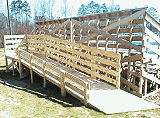 My daughter, Sally Cochran, owns and operate
the Equine Kingdom Riding Academy on their farm in Greensboro, North Carolina. Sally
is currently a Level 2 ARIA (American Riding Instructor's Association) instructor
certified in Recreational Riding and Hunt Seat on the Flat, a member of AQHA, NCHJA,
and PATH Int'l. She became a PATH (Professional Association of Therapeutic Horsemanship)
certified instructor in November 2012. In order to fully implement a therapeutic
riding program at Equine Kingdom, it was necessary to install a
mounting
platform and access ramp that can be used to assist people in wheelchairs and
with other disabilities in mounting and dismounting horses. Commercially made platforms/ramps
start at around $5,000, which is far too expensive for an operation like Equine
Kingdom. So, I researched some of the government's handicap access requirements
and designed the mounting platform and ramp shown below. As you might expect, there
are no shortage of regulations. Ramp angle, safety rail height... My daughter, Sally Cochran, owns and operate
the Equine Kingdom Riding Academy on their farm in Greensboro, North Carolina. Sally
is currently a Level 2 ARIA (American Riding Instructor's Association) instructor
certified in Recreational Riding and Hunt Seat on the Flat, a member of AQHA, NCHJA,
and PATH Int'l. She became a PATH (Professional Association of Therapeutic Horsemanship)
certified instructor in November 2012. In order to fully implement a therapeutic
riding program at Equine Kingdom, it was necessary to install a
mounting
platform and access ramp that can be used to assist people in wheelchairs and
with other disabilities in mounting and dismounting horses. Commercially made platforms/ramps
start at around $5,000, which is far too expensive for an operation like Equine
Kingdom. So, I researched some of the government's handicap access requirements
and designed the mounting platform and ramp shown below. As you might expect, there
are no shortage of regulations. Ramp angle, safety rail height...
 "The U.S. Air Force has a new stealth bomber:
Meet the
B-21
Raider. Officials with the U.S. Air Force and aerospace company Northrop Grumman
unveiled the newest aircraft in the U.S. fleet late Friday in a ceremony webcast
live online from the Edwards Air Force Base in California. The new bomber, built
by Northrop Grumman, will be the backbone of the Air Force's bomber fleet once it
enters service in a few years. It will also offer the first look at what are sure
to be next-generation aerospace capabilities that will likely become commonplace
in decades to come. 'The B-21 Raider is the first strategic bomber in more than
three decades,' U.S. Secretary of Defense Lloyd J. Austin said during the unveiling
ceremony. "It is a testament to America's enduring advantages in ingenuity and innovation.
And it's proof of the Department's long-term commitment to building advanced capabilities
that will fortify America's ability to deter aggression..." "The U.S. Air Force has a new stealth bomber:
Meet the
B-21
Raider. Officials with the U.S. Air Force and aerospace company Northrop Grumman
unveiled the newest aircraft in the U.S. fleet late Friday in a ceremony webcast
live online from the Edwards Air Force Base in California. The new bomber, built
by Northrop Grumman, will be the backbone of the Air Force's bomber fleet once it
enters service in a few years. It will also offer the first look at what are sure
to be next-generation aerospace capabilities that will likely become commonplace
in decades to come. 'The B-21 Raider is the first strategic bomber in more than
three decades,' U.S. Secretary of Defense Lloyd J. Austin said during the unveiling
ceremony. "It is a testament to America's enduring advantages in ingenuity and innovation.
And it's proof of the Department's long-term commitment to building advanced capabilities
that will fortify America's ability to deter aggression..."
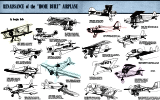 I was surprised when I saw the byline of
Douglas Rolfe for this "Renaissance
of the 'Home Built' Airplane" article in a 1961 issue of American Modeler magazine
in the table of contents. The title kind of implies it is an article discussing
the past and present of homebuilt airplanes, but actually it is a collection of
line drawings of various homebuilts, with a short narrative. The format fits with
Mr. Rolfe's usual contributions with his Auto Progress and Air Progress features.
One of the things he points out, which I didn't know, is that in the early 1930's
the CAA (predecessor to the FAA) regulated home builders out of the air by imposing
difficult to comply with rules. If history is any indicator, it was probably lobbyists
hired by aircraft manufacturers paying off politicians and bureaucrats to make life
hard on homebuilders. Fortunately, people like EAA founder Paul Poberenzny helped
reform the system to facilitate a rebirth of homebuilders... I was surprised when I saw the byline of
Douglas Rolfe for this "Renaissance
of the 'Home Built' Airplane" article in a 1961 issue of American Modeler magazine
in the table of contents. The title kind of implies it is an article discussing
the past and present of homebuilt airplanes, but actually it is a collection of
line drawings of various homebuilts, with a short narrative. The format fits with
Mr. Rolfe's usual contributions with his Auto Progress and Air Progress features.
One of the things he points out, which I didn't know, is that in the early 1930's
the CAA (predecessor to the FAA) regulated home builders out of the air by imposing
difficult to comply with rules. If history is any indicator, it was probably lobbyists
hired by aircraft manufacturers paying off politicians and bureaucrats to make life
hard on homebuilders. Fortunately, people like EAA founder Paul Poberenzny helped
reform the system to facilitate a rebirth of homebuilders...
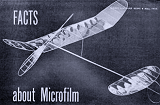 Microfilm-covered indoor models is one (of
many) aspects of model airplane building and flying that I've always wanted to try,
but never found the opportunity. You might be tempted to think this is the exclusive
realm of white-haired old men, and admittedly it nearly is, but when you look at
contest coverage in the modeling magazines, it is heartening to see a good showing
of youngsters. For that matter, the same holds true for just about all forms of
model aircraft these days except for radio controlled airplanes and helicopters.
As recently as a couple decades ago, radio equipment was too expensive for many
younger modelers to buy, so those who aspired to hobbies involving airborne craft
had to settle for free flight and control line. Now, the department store shelves
hold no control line or free flight models, but a nice selection of miniature R/C
helis and airplanes. But I digress. This 1954 Model Airplanes News magazine
article by John Zaic is a very comprehensive set of instructions on how to cover
airframes with microfilm, a pyroxylin... Microfilm-covered indoor models is one (of
many) aspects of model airplane building and flying that I've always wanted to try,
but never found the opportunity. You might be tempted to think this is the exclusive
realm of white-haired old men, and admittedly it nearly is, but when you look at
contest coverage in the modeling magazines, it is heartening to see a good showing
of youngsters. For that matter, the same holds true for just about all forms of
model aircraft these days except for radio controlled airplanes and helicopters.
As recently as a couple decades ago, radio equipment was too expensive for many
younger modelers to buy, so those who aspired to hobbies involving airborne craft
had to settle for free flight and control line. Now, the department store shelves
hold no control line or free flight models, but a nice selection of miniature R/C
helis and airplanes. But I digress. This 1954 Model Airplanes News magazine
article by John Zaic is a very comprehensive set of instructions on how to cover
airframes with microfilm, a pyroxylin...
 "South Korea's
first-ever
lunar orbiter Danuri has sent black-and-white photos of the Moon's surface and
Earth, the national space centre said Tuesday. Danuri - a portmanteau of the Korean
words for 'Moon' and 'enjoy' - was launched on a SpaceX rocket from the United States
in August 2022 and entered lunar orbit last month. Its images - taken between December
24 and January 1 - show the lunar surface and Earth, and were shot from less than
120 kilometres (75 miles) over the Moon, the Korea Aerospace Research Institute
(KARI) said in a statement. The images and videos will be 'used to select potential
sites for a Moon landing in 2032,' it added. Danuri is circling the Moon every two
hours, the centre said..." "South Korea's
first-ever
lunar orbiter Danuri has sent black-and-white photos of the Moon's surface and
Earth, the national space centre said Tuesday. Danuri - a portmanteau of the Korean
words for 'Moon' and 'enjoy' - was launched on a SpaceX rocket from the United States
in August 2022 and entered lunar orbit last month. Its images - taken between December
24 and January 1 - show the lunar surface and Earth, and were shot from less than
120 kilometres (75 miles) over the Moon, the Korea Aerospace Research Institute
(KARI) said in a statement. The images and videos will be 'used to select potential
sites for a Moon landing in 2032,' it added. Danuri is circling the Moon every two
hours, the centre said..."
 Finding an article in a modern model airplane
magazine like this "Carve
the Italian Beretta 9mm Pistol" from a 1954 issue of Air Trails is
highly unlikely. For that matters, seeing an advertisement like the Polk's Hobbies
Antique Gun Reproductions on the same page has equally low odds. It's not that boys
are no longer interested in guns, it's that publishers are afraid to promote them
in any manner - even for historical education purposes. Our politicians promote
policies that allow criminals to enter the country bringing drugs, weapons, and
other contraband; judges set criminals free or lightly sentence them; schools teach
kids that all guns by all people (including police and military) are bad, and then
want to remove all guns from law-abiding citizens. As the old saying goes, then
only the bad guys will have guns. The morons believe putting an orange cap at the
end of the barrel on toys guns will save the day, when all a criminal needs to do... Finding an article in a modern model airplane
magazine like this "Carve
the Italian Beretta 9mm Pistol" from a 1954 issue of Air Trails is
highly unlikely. For that matters, seeing an advertisement like the Polk's Hobbies
Antique Gun Reproductions on the same page has equally low odds. It's not that boys
are no longer interested in guns, it's that publishers are afraid to promote them
in any manner - even for historical education purposes. Our politicians promote
policies that allow criminals to enter the country bringing drugs, weapons, and
other contraband; judges set criminals free or lightly sentence them; schools teach
kids that all guns by all people (including police and military) are bad, and then
want to remove all guns from law-abiding citizens. As the old saying goes, then
only the bad guys will have guns. The morons believe putting an orange cap at the
end of the barrel on toys guns will save the day, when all a criminal needs to do...
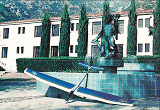 It was in this May 1975 issue of R/C
Modeler magazine that I first saw the
Airtronics Aquila
sailplane (way too graceful to refer to it as merely a glider). Airtronics had
not introduced a kit yet, but they were selling a canopy and hardware kit along
with plans, so I ordered them and scratch built my first Aquila. I was 17 years
old then. It was covered to look like the one in the photo above (which would become
the kit box label photo). Not having lite ply for the fuselage, I used hard balsa.
Somehow I eventually managed to destroy Aquila #1, but by that time a kit was available,
so I bought one and also the ABS plastic fuselage. A standard Hi-Start was used
for launching. A few years ago I built a 105% Aquila version simply because I wanted
another Aquila and had never built a sailplane with a wingspan greater than 99".
I am now in the process of building an 80% scale Aquila... It was in this May 1975 issue of R/C
Modeler magazine that I first saw the
Airtronics Aquila
sailplane (way too graceful to refer to it as merely a glider). Airtronics had
not introduced a kit yet, but they were selling a canopy and hardware kit along
with plans, so I ordered them and scratch built my first Aquila. I was 17 years
old then. It was covered to look like the one in the photo above (which would become
the kit box label photo). Not having lite ply for the fuselage, I used hard balsa.
Somehow I eventually managed to destroy Aquila #1, but by that time a kit was available,
so I bought one and also the ABS plastic fuselage. A standard Hi-Start was used
for launching. A few years ago I built a 105% Aquila version simply because I wanted
another Aquila and had never built a sailplane with a wingspan greater than 99".
I am now in the process of building an 80% scale Aquila...
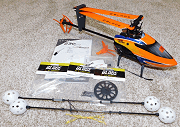 My
Blade 230 S Smart helicopter
was purchased in March of 2022 and is now for sale. I decided to sell because my
eyesight is too poor to see it well at more than a couple hundred feet. It has been
flown only in Stability Mode and always with the training gear shown. When programmed
per the user manual, the Blade flies very well and makes a good trainer. In order
to make it even more docile, I set the GER and Stability controls to 150% and the
servo throws to 50% (using my DX6 G3 transmitter - not included). With no wind it
will hover hands-off. With the custom-made training gear, it has never even come
close to tipping over. This is the Bind-n-Fly (BNF) version that did not come with
a transmitter, battery, or charger. Everything looks brand new, and there is no
damage to anything as far as I am aware. When buying the Blade 230 S, I bought
a few extra parts I haven't needed. They are included, as is the custom training
gear... My
Blade 230 S Smart helicopter
was purchased in March of 2022 and is now for sale. I decided to sell because my
eyesight is too poor to see it well at more than a couple hundred feet. It has been
flown only in Stability Mode and always with the training gear shown. When programmed
per the user manual, the Blade flies very well and makes a good trainer. In order
to make it even more docile, I set the GER and Stability controls to 150% and the
servo throws to 50% (using my DX6 G3 transmitter - not included). With no wind it
will hover hands-off. With the custom-made training gear, it has never even come
close to tipping over. This is the Bind-n-Fly (BNF) version that did not come with
a transmitter, battery, or charger. Everything looks brand new, and there is no
damage to anything as far as I am aware. When buying the Blade 230 S, I bought
a few extra parts I haven't needed. They are included, as is the custom training
gear...
 This website
exists entirely on the support of its visitors by way of a small percentage earned
with your
Amazon.com purchases. It typically works out to less than $10
per month. That barley covers the domain registration and secure server fees. If
you plan to buy items via
Amazon.com, please begin your shopping session from the AirplanesAndRockets.com
website so that I get credit for it. Doing so does not cost you anything extra.
Thank you for your support. This website
exists entirely on the support of its visitors by way of a small percentage earned
with your
Amazon.com purchases. It typically works out to less than $10
per month. That barley covers the domain registration and secure server fees. If
you plan to buy items via
Amazon.com, please begin your shopping session from the AirplanesAndRockets.com
website so that I get credit for it. Doing so does not cost you anything extra.
Thank you for your support.
 This advertisement from the July 1972 issue
of American Aircraft Modeler magazine might be the very first appearance
for the recently incorporated "Tower
Hobbies." Unlike other full-page and multiple-page ads that would soon follow,
this early example is all text, with the exception of the now very recognizable
company logo. According to the Tower Hobbies History webpage, "In 1971, founder
Bruce Holecek started Tower Hobbies with little more than a passion for RC and $800
savings." It also says the TowerHobbies.com website was launched in 1995, making
it one of the very earliest commercial World Wide Web (WWW) entities. The Wayback
Machine on Archive.org made its first capture on December 29, 1996, almost exactly
twenty-six years ago! Do you remember the spinning biplane? Animated GIF's were
a big deal back in the day. A Top Flite P-40 Warhawk cost $32.50 at the time, which
in today's hyper-inflation era works out to $230.92. That's an increase factor of
about 7.1x (810%) in 26 years... This advertisement from the July 1972 issue
of American Aircraft Modeler magazine might be the very first appearance
for the recently incorporated "Tower
Hobbies." Unlike other full-page and multiple-page ads that would soon follow,
this early example is all text, with the exception of the now very recognizable
company logo. According to the Tower Hobbies History webpage, "In 1971, founder
Bruce Holecek started Tower Hobbies with little more than a passion for RC and $800
savings." It also says the TowerHobbies.com website was launched in 1995, making
it one of the very earliest commercial World Wide Web (WWW) entities. The Wayback
Machine on Archive.org made its first capture on December 29, 1996, almost exactly
twenty-six years ago! Do you remember the spinning biplane? Animated GIF's were
a big deal back in the day. A Top Flite P-40 Warhawk cost $32.50 at the time, which
in today's hyper-inflation era works out to $230.92. That's an increase factor of
about 7.1x (810%) in 26 years...
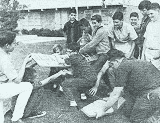 Every special interest organization has
had the equivalent of a "Junior
Problem" as reported in this 1968 issue of American Aircraft Modeler
magazine. It refers to efforts required to attract younger participants - pre-teen
and teenagers - into a particular activity, and then how to keep them interested
once involved. A common scenario is where a kid becomes interested in model airplanes,
boats, cars, etc., and sometimes becomes very involved - even to the point of competition
- and then abandons the realm once he enters college, goes off to work, raises a
family, or is distracted by more important priorities. Often, though, once the critical
responsibilities lessen, he returns to his former interest, this time with more
knowledge and money to more fully enjoy the hobby. Personally, I have retained my
interest in all things aeronautical and astronautical throughout my six-plus decades.
At times that involved only reading and maybe building a scale plastic model or
attempting to introduce my kids... Every special interest organization has
had the equivalent of a "Junior
Problem" as reported in this 1968 issue of American Aircraft Modeler
magazine. It refers to efforts required to attract younger participants - pre-teen
and teenagers - into a particular activity, and then how to keep them interested
once involved. A common scenario is where a kid becomes interested in model airplanes,
boats, cars, etc., and sometimes becomes very involved - even to the point of competition
- and then abandons the realm once he enters college, goes off to work, raises a
family, or is distracted by more important priorities. Often, though, once the critical
responsibilities lessen, he returns to his former interest, this time with more
knowledge and money to more fully enjoy the hobby. Personally, I have retained my
interest in all things aeronautical and astronautical throughout my six-plus decades.
At times that involved only reading and maybe building a scale plastic model or
attempting to introduce my kids...
 There is now a computer font available to
astronomers: Galaxy. Well, not really, not yet, but at some point there probably
will be. The rendition of "Welcome to Airplanes and Rockets! Founded 2006" shown
to the left was generated automatically by a website called "My Galaxies." Thanks to
thousands of volunteers worldwide that have participated in The Galaxy Zoo's project
of classifying galaxies, a set of letter-shaped galaxies has been identified that
can be used to write words like "airplanes and rockets." It appears that so far
God (or the Big Bang - take your pick) did not create a full set of upper case letter-shaped
galaxies. Some letters can be considered upper or lower case, like Cc Ii Jj Oo Pp
Ss Uu Vv Ww Xx Zz. As you might expect, there are number-shaped galaxies as well
(image right). After all, mathematics is the language of the universe. Judging by
the shape of the numbers ""1" and "7," and the fact that MyGalaxies.co.uk domain
is registered in the UK, I'm guessing the selected galaxy shapes are modeled after
the European-style numeral set... There is now a computer font available to
astronomers: Galaxy. Well, not really, not yet, but at some point there probably
will be. The rendition of "Welcome to Airplanes and Rockets! Founded 2006" shown
to the left was generated automatically by a website called "My Galaxies." Thanks to
thousands of volunteers worldwide that have participated in The Galaxy Zoo's project
of classifying galaxies, a set of letter-shaped galaxies has been identified that
can be used to write words like "airplanes and rockets." It appears that so far
God (or the Big Bang - take your pick) did not create a full set of upper case letter-shaped
galaxies. Some letters can be considered upper or lower case, like Cc Ii Jj Oo Pp
Ss Uu Vv Ww Xx Zz. As you might expect, there are number-shaped galaxies as well
(image right). After all, mathematics is the language of the universe. Judging by
the shape of the numbers ""1" and "7," and the fact that MyGalaxies.co.uk domain
is registered in the UK, I'm guessing the selected galaxy shapes are modeled after
the European-style numeral set...
 Here is a dark headline that come up in
a search for model airplane news: "Fan
Hurt by Model Plane At Halftime at Shea Dies; Disregard Charged." It is a
New York Times newspaper story dated December 15, 1979. This is probably
why you never see model airplanes being flown at public sports events anymore. I
remember back in the middle 1970's a few guys from the Prince Georges Radio Control
(PGRC) club to which I belonged at the time, did a demo show at a horse race track.
From the article: "One of two spectators struck by model airplane flown by remote
control as part of a halftime show during a New York Jets football game in Shea
Stadium last Sunday has died of his injuries. There are no Federal regulations governing
the flight of model airplanes, but witnesses said the model was being flown without
regard to an “advisory circular” put out by the Federal Aviation Administration
that recommends that such planes not be flown in heavily populated areas..." Here is a dark headline that come up in
a search for model airplane news: "Fan
Hurt by Model Plane At Halftime at Shea Dies; Disregard Charged." It is a
New York Times newspaper story dated December 15, 1979. This is probably
why you never see model airplanes being flown at public sports events anymore. I
remember back in the middle 1970's a few guys from the Prince Georges Radio Control
(PGRC) club to which I belonged at the time, did a demo show at a horse race track.
From the article: "One of two spectators struck by model airplane flown by remote
control as part of a halftime show during a New York Jets football game in Shea
Stadium last Sunday has died of his injuries. There are no Federal regulations governing
the flight of model airplanes, but witnesses said the model was being flown without
regard to an “advisory circular” put out by the Federal Aviation Administration
that recommends that such planes not be flown in heavily populated areas..."
 "NASA's quiet supersonic X-59 aircraft now
has the jet engine that will power it in flight. Earlier this month, at Lockheed
Martin's Skunk Works facility in Palmdale, California, the
F414-GE-100 engine was installed. This marks a major milestone as the X-59 approaches
the completion of its assembly. The F414-GE-100 engine from General Electric Aviation
measures 13-foot-long and packs 22,000 pounds of propulsion energy and will power
the X-59 as it flies at speeds up to Mach 1.4 and altitudes around 55,000 feet.
'The engine installation is the culmination of years of design and planning by the
NASA, Lockheed Martin, and General Electric Aviation teams,' said Ray Castner, NASA's
propulsion performance lead for the X-59. 'I am both impressed with and proud of
this combined team..." "NASA's quiet supersonic X-59 aircraft now
has the jet engine that will power it in flight. Earlier this month, at Lockheed
Martin's Skunk Works facility in Palmdale, California, the
F414-GE-100 engine was installed. This marks a major milestone as the X-59 approaches
the completion of its assembly. The F414-GE-100 engine from General Electric Aviation
measures 13-foot-long and packs 22,000 pounds of propulsion energy and will power
the X-59 as it flies at speeds up to Mach 1.4 and altitudes around 55,000 feet.
'The engine installation is the culmination of years of design and planning by the
NASA, Lockheed Martin, and General Electric Aviation teams,' said Ray Castner, NASA's
propulsion performance lead for the X-59. 'I am both impressed with and proud of
this combined team..."
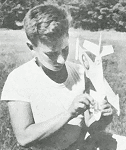 Jetex rocket motors were a big deal to my
friends and me in the early 1970s, although they had been around a lot longer than
that. In fact, this article in the March 1957 edition of American Modeler magazine
was printed a year before I was born. The motors did not product a whole lot of
thrust, so light weight was an absolute necessity. Once I finally got the buggers
lit, they worked well and made a really cool hissing noise as the fuel burned. However,
the amount of fuse wire provided never was enough to use up all the pellets in the
pack because the darn things kept going out as it tried to enter the nozzle. No
doubt it was my ineptness that caused the problem, but my excuse was only being
a dumb kid. Now, I have a whole lot of fuel pellets but no engines for them... Jetex rocket motors were a big deal to my
friends and me in the early 1970s, although they had been around a lot longer than
that. In fact, this article in the March 1957 edition of American Modeler magazine
was printed a year before I was born. The motors did not product a whole lot of
thrust, so light weight was an absolute necessity. Once I finally got the buggers
lit, they worked well and made a really cool hissing noise as the fuel burned. However,
the amount of fuse wire provided never was enough to use up all the pellets in the
pack because the darn things kept going out as it tried to enter the nozzle. No
doubt it was my ineptness that caused the problem, but my excuse was only being
a dumb kid. Now, I have a whole lot of fuel pellets but no engines for them...
 Ever
vigilant for ICBM's rocketing across the North Pole from Russia, NORAD maintains
a constant watch on the area, and needs to be careful not to get a false alarm when
Santa Claus takes off
The Night Before Christmas (aka Christmas Eve) with his sleigh full of toys
for good boys and girls. Assuming his sled has not been upgraded to some non-metallic
material, and that the bells on on Dasher, on Dancer, on Prancer, on Vixen, on Comet,
on Cupid, on Donner and on Blitzen (and Rudolph, of course) are still made of brass,
the radar cross section (RCS) is pretty significant and could easily be mistaken
for a missile in flight. After all, that sleigh must be moving at supersonic speeds
to cover the entire Earth in one day. Some people argue against a Santa Clause by
citing he could not possibly deliver presents to everyone in just a few hours, but
by trekking westward at an average of about 1,000 mph (relative to the equator)
he can exploit the surface rotation and remain in a given time zone. From everyone
at RF Cafe (that's Melanie and me), we say, "Happy Christmas to all, and to
all a good night!" Ever
vigilant for ICBM's rocketing across the North Pole from Russia, NORAD maintains
a constant watch on the area, and needs to be careful not to get a false alarm when
Santa Claus takes off
The Night Before Christmas (aka Christmas Eve) with his sleigh full of toys
for good boys and girls. Assuming his sled has not been upgraded to some non-metallic
material, and that the bells on on Dasher, on Dancer, on Prancer, on Vixen, on Comet,
on Cupid, on Donner and on Blitzen (and Rudolph, of course) are still made of brass,
the radar cross section (RCS) is pretty significant and could easily be mistaken
for a missile in flight. After all, that sleigh must be moving at supersonic speeds
to cover the entire Earth in one day. Some people argue against a Santa Clause by
citing he could not possibly deliver presents to everyone in just a few hours, but
by trekking westward at an average of about 1,000 mph (relative to the equator)
he can exploit the surface rotation and remain in a given time zone. From everyone
at RF Cafe (that's Melanie and me), we say, "Happy Christmas to all, and to
all a good night!"
 Even in 1975 when this "Helicopter
Action" column appeared in American Aircraft Modeler magazine a very
small percentage of R/C fliers had ever even tried their hands at helicopters, and
an even smaller portion had been successful enough to keep at it. Gyroscopes for
tail rotors were still in the prototype development stage, fixed pitch rotor blades
were the norm. Control over the rotor disc was not by direct linkage to the blades,
but to a rotor head assembly with a flybar. Only two servos were used - one for
left/right and one for fore/aft. When setting up controls to the swashplate, accounting
for gyroscopic precession was required since the desired output is 90° from the
input in the direction of rotation. It was counterintuitive to the fledgling helicopter
setter-upper, but like magic, it worked. It was during the setup of my DuBro TriStar
helicopter that I first learned of the concept (I was 18 years old). I say all that
to say this: Given the advanced state of the art in R/C helicopters today you might
think... Even in 1975 when this "Helicopter
Action" column appeared in American Aircraft Modeler magazine a very
small percentage of R/C fliers had ever even tried their hands at helicopters, and
an even smaller portion had been successful enough to keep at it. Gyroscopes for
tail rotors were still in the prototype development stage, fixed pitch rotor blades
were the norm. Control over the rotor disc was not by direct linkage to the blades,
but to a rotor head assembly with a flybar. Only two servos were used - one for
left/right and one for fore/aft. When setting up controls to the swashplate, accounting
for gyroscopic precession was required since the desired output is 90° from the
input in the direction of rotation. It was counterintuitive to the fledgling helicopter
setter-upper, but like magic, it worked. It was during the setup of my DuBro TriStar
helicopter that I first learned of the concept (I was 18 years old). I say all that
to say this: Given the advanced state of the art in R/C helicopters today you might
think...
 "Pictures of the sky can show us cosmic
wonders; movies can bring them to life. Movies from
NASA's NEOWISE space telescope are revealing motion and change across the sky.
Every six months, NASA's Near-Earth Object Wide Field Infrared Survey Explorer,
or NEOWISE, spacecraft completes one trip halfway around the Sun, taking images
in all directions. Stitched together, those images form an "all-sky" map showing
the location and brightness of hundreds of millions of objects. Using 18 all-sky
maps produced by the spacecraft (with the 19th and 20th to be released in March
2023), scientists have created what is essentially a time-lapse movie of the sky,
revealing changes that span a decade. Each map is a tremendous resource for astronomers,
but when viewed in sequence as a time-lapse, they serve as an even stronger resource
for trying to better understand the universe. Comparing the maps can reveal distant
objects that have changed position or brightness over time..." "Pictures of the sky can show us cosmic
wonders; movies can bring them to life. Movies from
NASA's NEOWISE space telescope are revealing motion and change across the sky.
Every six months, NASA's Near-Earth Object Wide Field Infrared Survey Explorer,
or NEOWISE, spacecraft completes one trip halfway around the Sun, taking images
in all directions. Stitched together, those images form an "all-sky" map showing
the location and brightness of hundreds of millions of objects. Using 18 all-sky
maps produced by the spacecraft (with the 19th and 20th to be released in March
2023), scientists have created what is essentially a time-lapse movie of the sky,
revealing changes that span a decade. Each map is a tremendous resource for astronomers,
but when viewed in sequence as a time-lapse, they serve as an even stronger resource
for trying to better understand the universe. Comparing the maps can reveal distant
objects that have changed position or brightness over time..."
 I just made a short video of my
Blade 230 S SMART helicopter
in flight to demonstrate how easy it is to fly in the Stability Mode (I've not tried
to fly in the Agility Mode). Easy, that is, after a trial−and−error method of programming
the Spektrum DX6 G3 transmitter. The setting shown in the user's manual leaves
the heli way too unstable IMHO. In order to make it trainer-like, I cranked the
servo throws back to 50% (default 100) and turned up the GER setting to 150 (100
default). Also in Forward Programming I set the Stability to 150 (its highest setting).
After that, she hovers hands−off when there's no wind. I had
Blade 230 S V2
prior to this (sold it), and it flew fine in Stability Mode using the manual's settings,
so something's different with the SAFE version. I was about to give up on flying
it until I made the setting adjustments. I might be willing to sell the heli w/training
gear, two 850 mAh Smart batteries and Smart Charger (w/IC2−IC3 adapter) for
$310 (+shipping) if you're interested. Tx not included. I just made a short video of my
Blade 230 S SMART helicopter
in flight to demonstrate how easy it is to fly in the Stability Mode (I've not tried
to fly in the Agility Mode). Easy, that is, after a trial−and−error method of programming
the Spektrum DX6 G3 transmitter. The setting shown in the user's manual leaves
the heli way too unstable IMHO. In order to make it trainer-like, I cranked the
servo throws back to 50% (default 100) and turned up the GER setting to 150 (100
default). Also in Forward Programming I set the Stability to 150 (its highest setting).
After that, she hovers hands−off when there's no wind. I had
Blade 230 S V2
prior to this (sold it), and it flew fine in Stability Mode using the manual's settings,
so something's different with the SAFE version. I was about to give up on flying
it until I made the setting adjustments. I might be willing to sell the heli w/training
gear, two 850 mAh Smart batteries and Smart Charger (w/IC2−IC3 adapter) for
$310 (+shipping) if you're interested. Tx not included.
 This website
exists entirely on the support of its visitors by way of a small percentage earned
with your
Amazon.com purchases. It typically works out to less than $10
per month. That barley covers the domain registration and secure server fees. If
you plan to buy items via
Amazon.com, please begin your shopping session from the AirplanesAndRockets.com
website so that I get credit for it. Doing so does not cost you anything extra.
Thank you for your support. This website
exists entirely on the support of its visitors by way of a small percentage earned
with your
Amazon.com purchases. It typically works out to less than $10
per month. That barley covers the domain registration and secure server fees. If
you plan to buy items via
Amazon.com, please begin your shopping session from the AirplanesAndRockets.com
website so that I get credit for it. Doing so does not cost you anything extra.
Thank you for your support.
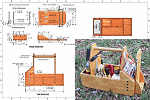 Since first posting photos and a description
of my Chameleon Field Box™ about
fifteen years ago, I have received many requests for plans. The plans were originally
drawn using Autodesk's AutoSketch v6.1, but I no longer have the program, and even
if I did, it probably won't run in Windows 10. A few years back I began re-drawing
the plans using Visio. After reviewing the plans, it appears I did everything except
the detachable transmitter holder. A JPG version of the plans can be downloaded
from my Chameleon Field Box™ webpage.
Depending on the phase of the moon, the prevailing wind, stock market activity,
or the color shirt I'm wearing, my interest in airplane activities alternate between
radio control, free flight, control line, static display, electric or glow fuel
power, or any other aspects of modeling. Over the years, I have designed and built
probably four or five different field boxes to accommodate the mood du jour. Each
was sold before moving on to the next design iteration. Finally, I decided that
rather than keeping on making new field boxes, it would make more sense to design
a one-size-fits-all version. The Chameleon
Field Box™, as I have dubbed it, comes pretty close to achieving that goal... Since first posting photos and a description
of my Chameleon Field Box™ about
fifteen years ago, I have received many requests for plans. The plans were originally
drawn using Autodesk's AutoSketch v6.1, but I no longer have the program, and even
if I did, it probably won't run in Windows 10. A few years back I began re-drawing
the plans using Visio. After reviewing the plans, it appears I did everything except
the detachable transmitter holder. A JPG version of the plans can be downloaded
from my Chameleon Field Box™ webpage.
Depending on the phase of the moon, the prevailing wind, stock market activity,
or the color shirt I'm wearing, my interest in airplane activities alternate between
radio control, free flight, control line, static display, electric or glow fuel
power, or any other aspects of modeling. Over the years, I have designed and built
probably four or five different field boxes to accommodate the mood du jour. Each
was sold before moving on to the next design iteration. Finally, I decided that
rather than keeping on making new field boxes, it would make more sense to design
a one-size-fits-all version. The Chameleon
Field Box™, as I have dubbed it, comes pretty close to achieving that goal...
 "Lockheed Martin is eyeing a mix of expendable
drone wingmen and more advanced autonomous systems for the U.S. Air Force to
team up with its manned fighters. The service could fly the expendable drones in
as soon as three years, the vice president and general manager of the company's
advanced development programs division, known as Skunk Works, said July 11. John
Clark said in a briefing with reporters before the Farnborough Airshow, scheduled
for July 18-22 in London, that the expendable drones will have a much lower price
point than the more advanced systems, making a quicker delivery easier. Lockheed
wants those expendable drones available should a conflict with China erupt sometime
this decade, as top U.S. Air Force officials said could happen. 'We're really talking
about something that could be operational in the next three to four years..." "Lockheed Martin is eyeing a mix of expendable
drone wingmen and more advanced autonomous systems for the U.S. Air Force to
team up with its manned fighters. The service could fly the expendable drones in
as soon as three years, the vice president and general manager of the company's
advanced development programs division, known as Skunk Works, said July 11. John
Clark said in a briefing with reporters before the Farnborough Airshow, scheduled
for July 18-22 in London, that the expendable drones will have a much lower price
point than the more advanced systems, making a quicker delivery easier. Lockheed
wants those expendable drones available should a conflict with China erupt sometime
this decade, as top U.S. Air Force officials said could happen. 'We're really talking
about something that could be operational in the next three to four years..."
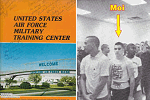 During this time of year 44 solar orbits
ago (yikes!), I was "enjoying" my fifth week of
USAF Basic
Training. It marked the transition from a trade in residential and commercial
electrical wiring to a career in electronics. November 9, 1978 was a date which
will live in infamy - for me, anyway. That was the day I left my comfortable, oblivious
20-year-old existence as an electrician in Mayo, MD, and boarded a Delta Airlines
flight to San Antonio, Texas. About six months earlier I had signed up under the
Delayed Enlistment program. I was on my way to becoming a fully trained and qualified
Weather Equipment Specialist, a career field chosen based on my keen interest in
weather phenomena, aviation, and aerospace. The plan was to survive six weeks of
Basic Training (BT) at Lackland Air Force Base, TX, and then go on to technical
school at Chanute AFB, IL. My first official act was to carry along with me a sealed
envelope containing the data of all enlistees boarding the flight from BWI airport,
to be surrendered to the sergeant who would ask for it upon arrival in San Antonio.
I was psyched. Following deboarding at SAT, a uniformed person directed our troupe
to a staging area while awaiting a bus for the ride to Lackland AFB. We were to
stand quietly, looking forward. It was a small sampling of what was to come. After
what seemed like a long bus ride, we drove past the guard house at the gate, rode
to some building and were led into a dining hall for grub... During this time of year 44 solar orbits
ago (yikes!), I was "enjoying" my fifth week of
USAF Basic
Training. It marked the transition from a trade in residential and commercial
electrical wiring to a career in electronics. November 9, 1978 was a date which
will live in infamy - for me, anyway. That was the day I left my comfortable, oblivious
20-year-old existence as an electrician in Mayo, MD, and boarded a Delta Airlines
flight to San Antonio, Texas. About six months earlier I had signed up under the
Delayed Enlistment program. I was on my way to becoming a fully trained and qualified
Weather Equipment Specialist, a career field chosen based on my keen interest in
weather phenomena, aviation, and aerospace. The plan was to survive six weeks of
Basic Training (BT) at Lackland Air Force Base, TX, and then go on to technical
school at Chanute AFB, IL. My first official act was to carry along with me a sealed
envelope containing the data of all enlistees boarding the flight from BWI airport,
to be surrendered to the sergeant who would ask for it upon arrival in San Antonio.
I was psyched. Following deboarding at SAT, a uniformed person directed our troupe
to a staging area while awaiting a bus for the ride to Lackland AFB. We were to
stand quietly, looking forward. It was a small sampling of what was to come. After
what seemed like a long bus ride, we drove past the guard house at the gate, rode
to some building and were led into a dining hall for grub...
 These "Sketchbook"
pages appeared for many years in Air Trails Hobbies for Young Men magazine
and in its predecessor, Air Trails. "Sketchbook" was a monthly feature
where modelers wrote to the magazine with handy ideas for saving time and/or money,
and just for offering tips and suggestions on a different way of doing something.
Prior to having information on just about every topic readily available on the Internet,
modelers had to rely on books, magazines, friends, and personal ingenuity. Also,
in those days there was not the plethora of accessories available for building models,
so a lot of creativity was involved. Even items as commonplace as bellcranks for
control line models and dethermalizers for free flight were fabricated from salvaged
parts like metal soup cans and hairpins. I'm guessing no magazine today would dare
publish a scheme to attach bottle rockets to a model airplane as is shown here,
lest Homeland Security or the FBI show up at the editor's door in the early morning
hours with a fully outfitted SWAT team... These "Sketchbook"
pages appeared for many years in Air Trails Hobbies for Young Men magazine
and in its predecessor, Air Trails. "Sketchbook" was a monthly feature
where modelers wrote to the magazine with handy ideas for saving time and/or money,
and just for offering tips and suggestions on a different way of doing something.
Prior to having information on just about every topic readily available on the Internet,
modelers had to rely on books, magazines, friends, and personal ingenuity. Also,
in those days there was not the plethora of accessories available for building models,
so a lot of creativity was involved. Even items as commonplace as bellcranks for
control line models and dethermalizers for free flight were fabricated from salvaged
parts like metal soup cans and hairpins. I'm guessing no magazine today would dare
publish a scheme to attach bottle rockets to a model airplane as is shown here,
lest Homeland Security or the FBI show up at the editor's door in the early morning
hours with a fully outfitted SWAT team...
 "China's
largest amphibious aircraft has completed critical flight tests on September
27, 2022, and is slated to go into service by the end of 2024. Developed by the
Aviation Industry Corporation of China, the AG600 aircraft family will support the
country's emergency rescue capabilities. The AG600M model is specifically designed
to combat forest fires and can carry up to 12 tonnes of water and fly as far as
4,500km (2,796 miles)..." "China's
largest amphibious aircraft has completed critical flight tests on September
27, 2022, and is slated to go into service by the end of 2024. Developed by the
Aviation Industry Corporation of China, the AG600 aircraft family will support the
country's emergency rescue capabilities. The AG600M model is specifically designed
to combat forest fires and can carry up to 12 tonnes of water and fly as far as
4,500km (2,796 miles)..."
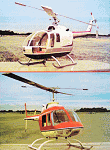 In August 1973 (the 18th), I was just turning
15 years old and could only dream of owning an R/C airplane, much less an R/C helicopter.
It was still a time when very few people possessed the skill or money to become
proficient enough at flying helis to consider competing in a contest. There were
no programmable radios, and the metal-to-metal contact of gears and mechanical connections
wreaked havoc on the 72 MHz receivers. Gyros were of the Hiller mechanical type;
piezoelectric versions that integrated with the tail rotor servo were yet to be
invented. Many of the models that appeared at the
1973 Helicopter Nationals
were either entirely home built, or modified from a standard kit. Having struggled
with a DuBro TriStar helicopter myself in the late 1970s, I can attest to the difficulty
posed by trying to keep the tail under control when engine speed changed, which
was constantly since fixed pitch was the rule of the day. Thank goodness for modern
inventions that allow just about anyone to successfully an R/C helicopter... In August 1973 (the 18th), I was just turning
15 years old and could only dream of owning an R/C airplane, much less an R/C helicopter.
It was still a time when very few people possessed the skill or money to become
proficient enough at flying helis to consider competing in a contest. There were
no programmable radios, and the metal-to-metal contact of gears and mechanical connections
wreaked havoc on the 72 MHz receivers. Gyros were of the Hiller mechanical type;
piezoelectric versions that integrated with the tail rotor servo were yet to be
invented. Many of the models that appeared at the
1973 Helicopter Nationals
were either entirely home built, or modified from a standard kit. Having struggled
with a DuBro TriStar helicopter myself in the late 1970s, I can attest to the difficulty
posed by trying to keep the tail under control when engine speed changed, which
was constantly since fixed pitch was the rule of the day. Thank goodness for modern
inventions that allow just about anyone to successfully an R/C helicopter...
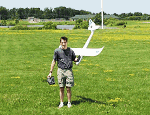 After about a 12-month hiatus from flying
any kind of model airplane, and having sold all of my RC gear prior to moving to
Erie, PA, I looked around for something that would get me back into the air quickly.
My first inclination was to build yet another Spirit 2-meter sailplane and put a
brushless motor in it like before, but I really didn't want to have to take the
time to build it first. I also did not particularly care for most of the ARF gliders
that were available, but seeing the ParkZone
Radian sailplane on the Horizon Hobby website and watching the video of its
flight convinced me to spring the $250 for the RTF version. There certainly is no
better value out there - a nice-looking sailplane with brushless motor and controller,
servos, a 3-cell Li-Po battery, and a charger, along with a 2.4 GHz spread spectrum
radio system. You cannot buy the parts individually for that much. See September
7, 2009 update: Assembly was a piece of cake - just slide the horizontal stabilizer
/ elevator into place and secure it with the supplied clear tape, then connect the
pushrod wire to the control horn... After about a 12-month hiatus from flying
any kind of model airplane, and having sold all of my RC gear prior to moving to
Erie, PA, I looked around for something that would get me back into the air quickly.
My first inclination was to build yet another Spirit 2-meter sailplane and put a
brushless motor in it like before, but I really didn't want to have to take the
time to build it first. I also did not particularly care for most of the ARF gliders
that were available, but seeing the ParkZone
Radian sailplane on the Horizon Hobby website and watching the video of its
flight convinced me to spring the $250 for the RTF version. There certainly is no
better value out there - a nice-looking sailplane with brushless motor and controller,
servos, a 3-cell Li-Po battery, and a charger, along with a 2.4 GHz spread spectrum
radio system. You cannot buy the parts individually for that much. See September
7, 2009 update: Assembly was a piece of cake - just slide the horizontal stabilizer
/ elevator into place and secure it with the supplied clear tape, then connect the
pushrod wire to the control horn...
 "NASA's
Orion space capsule, which is in day 15 of its Artemis 1 test flight, is
scheduled to leave its current distant retrograde orbit on Thursday, as the spacecraft
begins the process of returning home to Earth. Artemis 1 mission management
leaders provided a preview on Wednesday, from Johnson Space Center, of the upcoming
maneuver that will ultimately send the test flight past the moon and back to Earth
on Dec. 11. "The distant retrograde departure, which is scheduled as part of
a planned maneuver on Dec. 1, in the afternoon, and then followed by the return
powered flyby scheduled for Dec. 5, in the morning," Mike Sarafin, NASA Artemis
1 Mission Manager, said at Wednesday's briefing. "That will begin the process of..." "NASA's
Orion space capsule, which is in day 15 of its Artemis 1 test flight, is
scheduled to leave its current distant retrograde orbit on Thursday, as the spacecraft
begins the process of returning home to Earth. Artemis 1 mission management
leaders provided a preview on Wednesday, from Johnson Space Center, of the upcoming
maneuver that will ultimately send the test flight past the moon and back to Earth
on Dec. 11. "The distant retrograde departure, which is scheduled as part of
a planned maneuver on Dec. 1, in the afternoon, and then followed by the return
powered flyby scheduled for Dec. 5, in the morning," Mike Sarafin, NASA Artemis
1 Mission Manager, said at Wednesday's briefing. "That will begin the process of..."
 This is a very interesting article about
the
FCC's "Secrecy of Communications" rules. Manmade radio interference (QRM in
Ham lingo), has been a problem since the early days of wireless communications.
You might convincingly argue that it was worse at a time when many transmitters
were of the arc type that basically spewed out a mess of RF energy within a specified
bandwidth (very wide compared to today) to signal the presence of a "dit" (a digital
"1"), with the absence of a signal being a "dah" (digital "0"). Filter technology
for both the transmit and receive sides was also poor, allowing unintentional RF
noise to be sent over the air and to find its way into the detector circuits. The
Federal Communications Commission (FCC), first formed in 1934, nearly four decades
after Guglielmo Marconi first demonstrated his wireless set in 1896. Sometime around
1952, the FCC allocated a half dozen frequencies in the 27 MHz for radio control
(R/C) model use, mixed within the existing citizens band (CB) radio channels. As
you might imagine, interference problems were rampant, especially near metro areas
and highways with heavy truck traffic. This editorial in a 1969 issue of American
Aircraft Modeler magazine reports on just how bad things had gotten, especially
that caused by operators using faulty and/or illegally modified transmitters, and
even by malicious intentional attempts to "shoot down" model airplanes by keying
transmitters in the vicinity of flight activity. In 1965, the FCC allocated... This is a very interesting article about
the
FCC's "Secrecy of Communications" rules. Manmade radio interference (QRM in
Ham lingo), has been a problem since the early days of wireless communications.
You might convincingly argue that it was worse at a time when many transmitters
were of the arc type that basically spewed out a mess of RF energy within a specified
bandwidth (very wide compared to today) to signal the presence of a "dit" (a digital
"1"), with the absence of a signal being a "dah" (digital "0"). Filter technology
for both the transmit and receive sides was also poor, allowing unintentional RF
noise to be sent over the air and to find its way into the detector circuits. The
Federal Communications Commission (FCC), first formed in 1934, nearly four decades
after Guglielmo Marconi first demonstrated his wireless set in 1896. Sometime around
1952, the FCC allocated a half dozen frequencies in the 27 MHz for radio control
(R/C) model use, mixed within the existing citizens band (CB) radio channels. As
you might imagine, interference problems were rampant, especially near metro areas
and highways with heavy truck traffic. This editorial in a 1969 issue of American
Aircraft Modeler magazine reports on just how bad things had gotten, especially
that caused by operators using faulty and/or illegally modified transmitters, and
even by malicious intentional attempts to "shoot down" model airplanes by keying
transmitters in the vicinity of flight activity. In 1965, the FCC allocated...
 Things were all so simple then; time has
rewritten every line - to paraphrase a popular song from the mid-1970's. That was
the era when this 1975 issue of American Aircraft Modeler magazine ran
the
Electric Flight Action column by Mitch Poling. Having just entered into the
radio control (R/C) phase of aeromodeling at the time, I was not too overly interested
in electric flight since my prior experience had been with glow fuel powered control
line models. Electric propulsion systems were overly heavy, overly large, and underly
(sic) powerful. Brushed motors with standard magnets, and usually without ball bearings
on the shaft lacked the power of today's brushless motors. Nickel cadmium (NiCad)
batteries have about a quarter the energy storage density as lithium types (Li-Ion
or Li-Po, so combined with the low efficiency of the motors, flight times were very
short. My first experience with an R/C e-powered model was a Great Plane Spectra
sailplane, which was a powered version of their 2-Meter Spirit glider. a while later
I tried a Carl Goldberg Mirage 550 e-powered model. Both were plagued with
brush and commutator problems. All of those issues have been solved with modern
brushless motors and Li-Po batteries - which have their own issues, primarily cost
and fire hazards. I wonder whether modern material and methods... Things were all so simple then; time has
rewritten every line - to paraphrase a popular song from the mid-1970's. That was
the era when this 1975 issue of American Aircraft Modeler magazine ran
the
Electric Flight Action column by Mitch Poling. Having just entered into the
radio control (R/C) phase of aeromodeling at the time, I was not too overly interested
in electric flight since my prior experience had been with glow fuel powered control
line models. Electric propulsion systems were overly heavy, overly large, and underly
(sic) powerful. Brushed motors with standard magnets, and usually without ball bearings
on the shaft lacked the power of today's brushless motors. Nickel cadmium (NiCad)
batteries have about a quarter the energy storage density as lithium types (Li-Ion
or Li-Po, so combined with the low efficiency of the motors, flight times were very
short. My first experience with an R/C e-powered model was a Great Plane Spectra
sailplane, which was a powered version of their 2-Meter Spirit glider. a while later
I tried a Carl Goldberg Mirage 550 e-powered model. Both were plagued with
brush and commutator problems. All of those issues have been solved with modern
brushless motors and Li-Po batteries - which have their own issues, primarily cost
and fire hazards. I wonder whether modern material and methods...
|